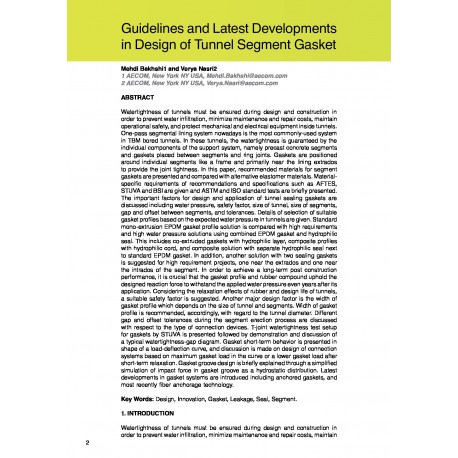Cart
0
0
No document
0,00 €
Total
Document successfully added to your shopping cart
Quantity
Total
There are 0 items in your cart.
There is 1 item in your cart.
Total documents
Total shipping
To be determined
Total
Search & filter
Search for a publication
Search & filter

Guidelines and Latest Developments in Design of Tunnel Segment Gasket
2994_guidelines_and_latest_devel
Watertightness of tunnels must be ensured during design and construction in order to prevent water infiltration, minimize maintenance and repair costs, maintain operational safety, and protect mechanical and electrical equipment inside tunnels. One-pass segmental lining system nowadays is the most commonly-used system in TBM bored tunnels. In these tunnels, the watertightness is guaranteed by the individual components of the support system, namely precast concrete segments and gaskets placed between segments and ring joints. Gaskets are positioned around individual segments like a frame and primarily near the lining extrados to provide the joint tightness. In this paper, recommended materials for segment gaskets are presented and compared with alternative elastomer materials. Materialspecific requirements of recommendations and specifications such as AFTES, STUVA and BSI are given and ASTM and ISO standard tests are briefly presented. The important factors for design and application of tunnel sealing gaskets are discussed including water pressure, safety factor, size of tunnel, size of segments, gap and offset between segments, and tolerances. Details of selection of suitable gasket profiles based on the expected water pressure in tunnels are given. Standard mono-extrusion EPDM gasket profile solution is compared with high requirements and high water pressure solutions using combined EPDM gasket and hydrophilic seal. This includes co-extruded gaskets with hydrophilic layer, composite profiles with hydrophilic cord, and composite solution with separate hydrophilic seal next to standard EPDM gasket. In addition, another solution with two sealing gaskets is suggested for high requirement projects, one near the extrados and one near the intrados of the segment. In order to achieve a long-term post construction performance, it is crucial that the gasket profile and rubber compound uphold the designed reaction force to withstand the applied water pressure even years after its application. Considering the relaxation effects of rubber and design life of tunnels, a suitable safety factor is suggested. Another major design factor is the width of gasket profile which depends on the size of tunnel and segments. Width of gasket profile is recommended, accordingly, with regard to the tunnel diameter. Different gap and offset tolerances during the segment erection process are discussed with respect to the type of connection devices. T-joint watertightness test setup for gaskets by STUVA is presented followed by demonstration and discussion of a typical watertightness-gap diagram. Gasket short-term behavior is presented in shape of a load-deflection curve, and discussion is made on design of connection systems based on maximum gasket load in the curve or a lower gasket load after short-term relaxation.


